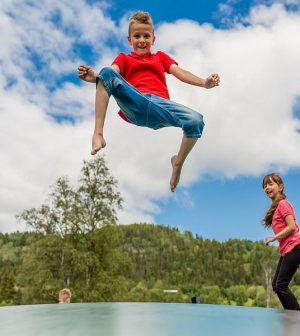- Skip Storing This Everyday Product in the Fridge Door
- Green Tea + B3 Pairing May Boost Brain Health
- Navigating Your Midlife Crisis: Embracing New Possibilities
- City Raccoons Showing Signs of Domestication
- Mapping the Exposome: Science Broadens Focus to Environmental Disease Triggers
- One Week Less on Social Media Linked to Better Mental Health
- Your Brain Changes in Stages as You Age, Study Finds
- Some Suicide Victims Show No Typical Warning Signs, Study Finds
- ByHeart Formula Faces Lawsuits After Babies Sickened With Botulism
- Switch to Vegan Diet Could Cut Your Greenhouse Gas Emissions in Half
Experts’ Guide to Trampoline Safety

If you own or use trampolines, you need to take steps to prevent injuries, the American Academy of Orthopaedic Surgeons (AAOS) says.
While trampolines are fun and can help improve coordination and strengthen the musculoskeletal system, serious injuries can occur without proper safety measures.
In 2018, nearly 314,000 trampoline-related injuries were treated in U.S. emergency departments, doctors’ offices and clinics, according to the Consumer Product Safety Commission.
A recent article in the Journal of the American Academy of Orthopaedic Surgeons noted that a higher percentage of fractures have been linked to trampoline and jump parks than home trampolines.
“Many injuries come from multiple people jumping at once,” AAOS spokesman and pediatric orthopedic surgeon Dr. L. Reid Nichols said in an academy news release. “To limit injuries, ensure only one participant on a trampoline at a time. … Ensure rules are implemented and followed. Check also with your insurance rider before purchasing a home trampoline.”
The AAOS offered the following trampoline safety tips:
- Don’t let children younger than 6 years old use trampolines and remove trampoline ladders after use to prevent unsupervised jumping.
- Regularly check equipment and discard worn or damaged equipment if replacement parts aren’t available.
- Make sure that supporting bars, strings and surrounding landing surfaces have adequate protective padding. See that the padding is in good condition and properly positioned.
- Don’t depend only on safety net enclosures for injury prevention; most injuries occur on the trampoline surface.
- Ensure that there are spotters when participants are jumping. Somersaults or high-risk maneuvers should not be done without proper instruction and supervision, and should be attempted only with protective equipment, such as a harness.
More information
The American Academy of Pediatrics has more on trampoline risks.
Source: HealthDay
Copyright © 2025 HealthDay. All rights reserved.










